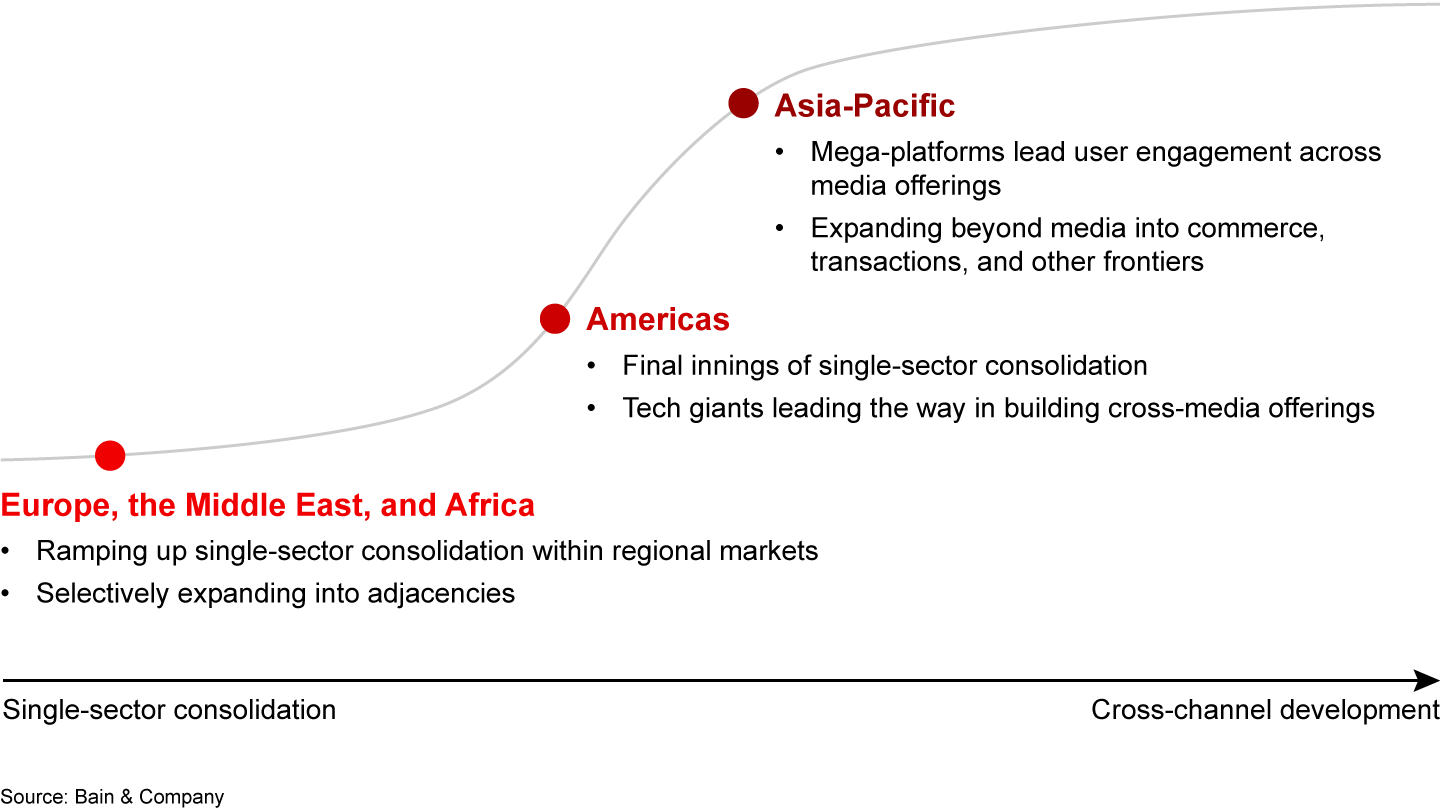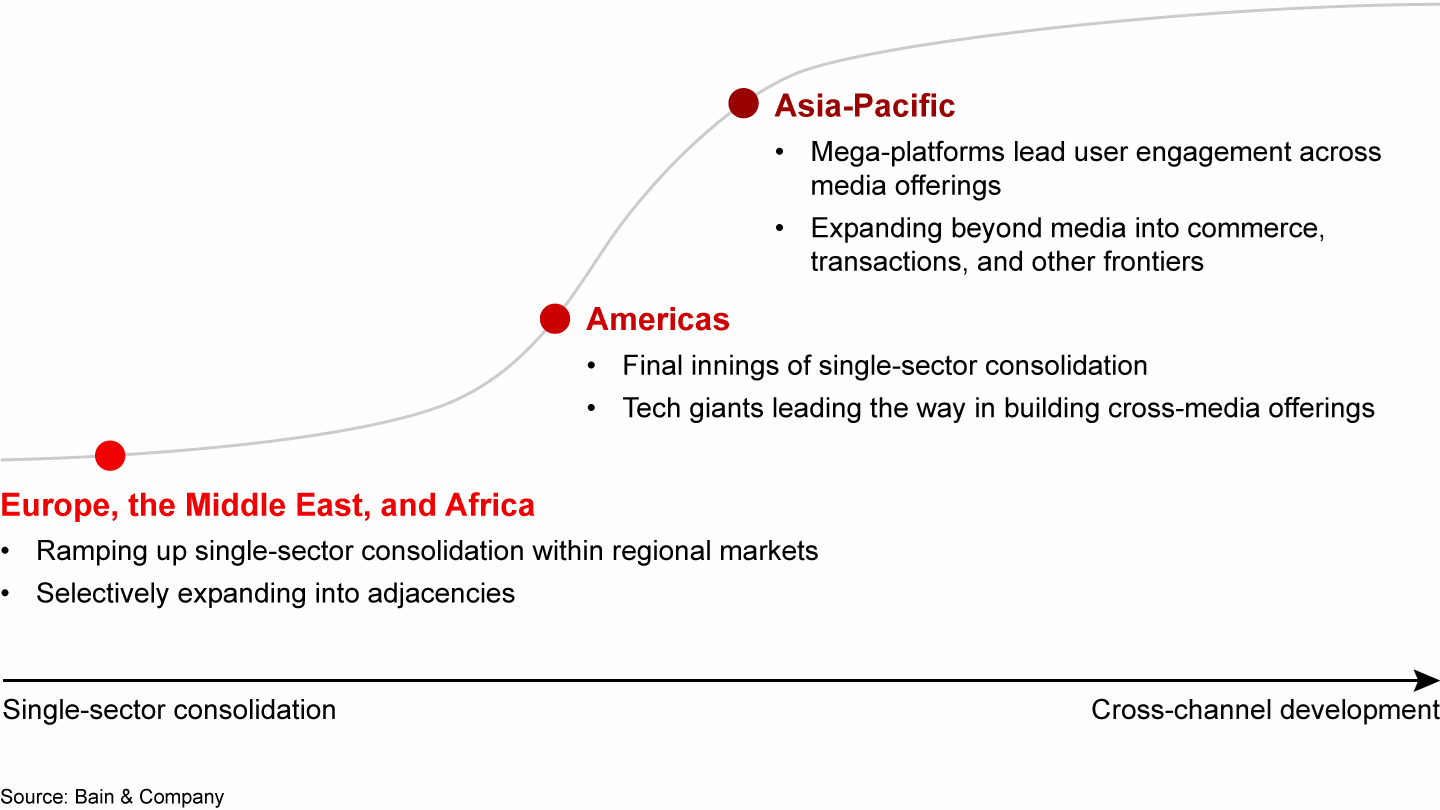M&A Report

At a Glance
- To retain customers, media and entertainment companies are buying companies that allow them to move beyond their video and audio roots.
- Cross-sector growth will look different in different geographic markets. Farthest along on the curve, China’s WeChat blends social media, gaming, and retail experiences into a single platform.
- Media companies that reach across consumer sectors with a global network for content creation and consumption will be best positioned to capture, retain, and monetize high-volume consumer engagement.
- The tail of single-sector consolidation continues, with deals such as the announced Microsoft acquisition of Activision and WarnerMedia-Discovery merger.
This article is part of Bain's 2022 M&A Report.
The past five years of media M&A have been dominated by scale deals that enabled the direct-to-consumer (D2C) and streaming shift. Now, sustained economics will depend on retaining these D2C customers and deepening engagement with them by extending the boundaries of media well beyond audio and video and into areas such as video gaming, fitness, betting, and location-based entertainment.
Some of the largest video platforms have already begun moving in this direction. For example, Netflix’s foray into video gaming is just the beginning of the next wave of media M&A.
In this race to add new media offerings, consumer engagement types, and geographies, some companies find themselves well positioned to expand organically to large user bases and dip their toes into other sectors. That’s particularly the case among companies with a strong technological orientation and a history of successful cross-sector expansion. Others need to selectively grow with partnerships, particularly if some of the most exciting intellectual property tie-ins are well beyond their core. And there is growing interest in scope M&A.
We expect the shift to result in an uptick of M&A activity in the media and entertainment industry and especially in smaller deals. But as companies pursue scope deals or partnerships to enter new businesses, they are learning that the rules for such deals are different than they are for acquisitions aimed at building scale in a similar business.
Giving consumers blended, unified experiences
This trend starts with the recognition that consumers increasingly multitask across media forms and enjoy blended, unified experiences and that mega-platforms will look differently in different parts of the world. In the US, it will take the form of social media tie-ins with popular TV shows or gaming experiences that link to favorite musical artists, for example. In China, where the mega-platform trend first surfaced, it looks like completely integrated in-app universes, such as WeChat’s blending of social media, gaming, and retail experiences into a single platform.
In addition to cross-sector growth there is cross-regional activity. Consumers connected to a global online community now have increased exposure to a diverse base of content. Think about the rise of K-pop on the US music charts or the popularity of Turkish dramas on Spanish-language television. In this new age, the media companies that reach across consumer sectors with a global network for content creation and consumption will be best positioned to capture, retain, and monetize high-volume consumer engagement.
Consumers now have increased exposure to a diverse base of content. Think about the rise of K-pop on the US music charts or the popularity of Turkish dramas on Spanish-language television.
The regional view
Although all regions are moving in the same direction, different markets are further along in this journey (see Figure 1).
Asia is furthest along in expanding the boundaries of media M&A


Asia is the birthplace of the mega-platform. Again, WeChat’s ecosystem offers social media functions, gaming, and even sectors outside of media, such as retail. With more than 1 billion active monthly users, WeChat has created highly unified sources of market power.
The trend to think not just cross-sector but globally for the best assets extends within more specialized companies in Asia, too. For example, South Korean music powerhouse HYBE, which already spans recording, live entertainment, publishing, and more, acquired Scooter Braun’s US-based Ithaca Holdings to expand its global reach.
While not quite as far along the curve as some of the largest Asian conglomerates, big US media and entertainment companies are acknowledging the need for new platforms, technology, and the blurring of sector boundaries. The tail of single-sector consolidation continues, with deals such as the announced Microsoft acquisition of Activision and WarnerMedia-Discovery merger as well as the Televisa-Univision merger. Near adjacencies also are still rife, with deals such as the Madison Square Garden Entertainment acquisition of MSG Networks. But the most forward-thinking media and entertainment companies know that retaining a competitive edge with consumers means thinking more broadly and looking farther afield.
The most forward-thinking media and entertainment companies know that retaining a competitive edge with consumers means thinking more broadly and looking farther afield.
Social media companies are making some of the boldest moves with their heavy investment in augmented reality/virtual reality, the metaverse, and social commerce—Facebook’s recent rebrand to Meta is a giant step in this direction. In video, consider Netflix’s expansion into gaming. Although its initial gaming efforts involved organic tie-ins to video content, Netflix appears to be ramping into what will likely be a broader offering with its proposed acquisition of Night School Studio.
Europe, the Middle East, and Africa are in the early days of building cross-media platforms. Many of the biggest deals are still pulling the region toward that first step, the single-sector consolidation. In video, the merger of Groupe TF1 and Groupe M6 came with stated plans for investing in live streaming and subscription video on demand. Eventually, these deals will broaden and move not only into the digital future for their specific sector but also across other new media forms. In 2021, Bertelsmann combined its TV and publishing divisions, Mediengruppe RTL Deutschland and Gruner + Jahr, in Germany to support the expansion of its streaming platform, RTL+, beyond video into a variety of digital content.
Asking the right questions
Whichever geography you’re in, the trend is toward bigger platforms that can offer consumers a broader suite of experiences, whether with a mega-platform or consolidated single sector. As regions reach the mega-platform stage, however, executives must make the transition from the scale deals that have historically driven industry growth to the scope deals that are likely to fuel growth in the future. Indeed, companies interested in scope M&A beyond adjacencies need to acknowledge that these deals require different approaches than acquisitions aimed at building scale in an existing business.
That starts by asking a fundamental question: From a brand and consumer equity standpoint, are you really a credible seller of the new service?
Next, invest to clearly understand the deep consumer need in your region—the customer base as well as the available acquisition targets. Which offerings go together with which consumer segments? For example, consumers of a company’s gaming services will not necessarily want the same offerings as Netflix’s subscribers.
Ask this fundamental question: Are you really a credible seller of the new service?
Understand what enablers (beyond bundling) are required for the cross-sector experience. If you have video and music, what is the integration that will make it seamless for consumers? Are the recommendations the same for each? Also, be prepared to change your operating model to enable the cross-pollination and deeper integration required.
Assess your own actual realistic technology expansion capabilities. Some management teams lack the experience to expand from video to music, for example. They’re just not well equipped to acquire a company in a scope deal and merge it to create a seamless platform. They need the training that can come from joint ventures and partnerships.
You need conviction from the financial markets. If you’re buying a gaming company, it likely has a different investor profile than a video company. Make sure that you’re not pulling down the multiple—you can destroy value.
Ultimately, the best M&A strategy includes knowing when not to do deals. So, instead of jumping on the M&A bandwagon, the better answer may be to consider partnerships or joint ventures as an initial move toward building a mega-platform. Ultimately, M&A activity must work to build on a company’s strengths and not to create a mega-flop.